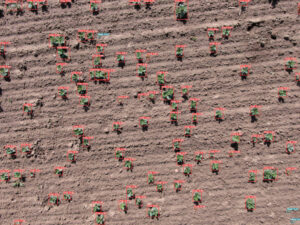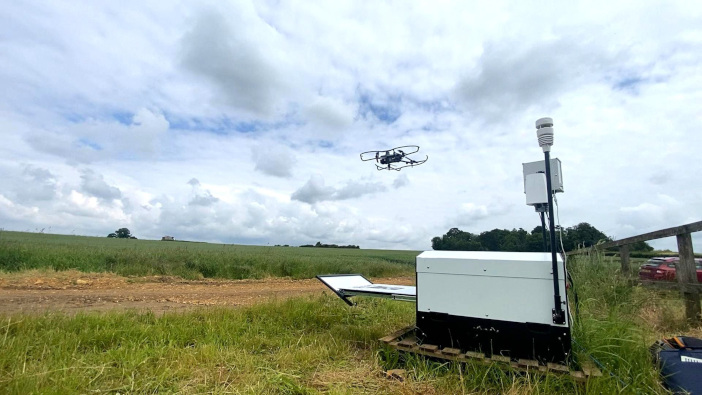As the company’s latest round of crowdfunding comes to a close, we dropped in to Drone Ag to see how drone technology is set to benefit the UK agricultural sector
The same week that we visited the offices of Drone Ag, the company had just taken part in the launch of the UK Agricultural Drone Industry Association (UKADIA), an industry body made up of technology firms, companies already using drone systems, agribusinesses and pilots.
“UKADIA has been set up to be an industry-led, representative body, that will mediate between industry stakeholders and regulators, such as the Chemical Regulations Division (CRD) and the Civil Aviation Authority (CAA), to push regulations further with real-world application data, and promote safe use and best practice to those looking to use agricultural drones within their businesses,” explains Alex Macdonald-Smith, chief operations officer at Drone Ag.
Previous conversations about drone technology in agriculture have occasionally felt like blue-sky thinking, because of the slow pace of regulation. Things appear to be speeding up in this regard, however, with special approvals being given to select companies for beyond visual line of sight (BVLOS) applications, enabling drones to be piloted or automated out of sight from the operator.
According to Jack Wrangham, chief executive officer, this is key to the next stage of the Drone Ag system. “Our long-term plan is the introduction of automated base stations, with operations controlled from a central base – initially here in the UK,” he explains. “We currently have systems out for both Syngenta and Agrii trial plots, as well as applications in Italy, which will still be monitored from our base in Northumberland.”
For the short term, this will place Drone Ag in the ‘farming as a service’ category; essentially, a contractor that will work with farmers and agronomists. As the market develops, the company will then sell commercial specification versions of the base station (available from next year) for other contractors to use with their clients.
Skippy Scout
It still isn’t legal to use drones to apply any product with a Ministerially Approved Pesticide Product (MAPP) number outside of CRD-approved trials. Untreated seeds can be broadcast, as is indeed one of the main uses for drones currently; however, those dressed with products such as insecticides cannot.
Alongside seeding, other operations that can currently be handled by drones include the application of shading to greenhouses, as well as applying biostimulants and other nutrient products such as urea and foliar fertilisers.
While the industry waits for the gradual approval of chemical applications – which will also need support from the crop protection product industry, with label approvals for drone application – Jack sees the use of drones to speed up data collection, particularly for agronomists at present.
 “With our Skippy Scout system, we can limit the time required when crop walking,” he says. “We can collect images at such a high resolution that the AI can conduct plant counts, as well as differentiate between the crop and weeds to highlight pressure.”
“With our Skippy Scout system, we can limit the time required when crop walking,” he says. “We can collect images at such a high resolution that the AI can conduct plant counts, as well as differentiate between the crop and weeds to highlight pressure.”
At present, crop counting and weed identification can be done in any broadleaf crops, as well as in potatoes. A cereal plant counting model is coming soon, although Jack acknowledges that the window for this is very short. Another model in development is plant sizing.
As seeding applications gain approval – both regulatory and commercial – Jack also believes that the high resolution will enable users to assess the effectiveness of drone operations. “We’ve seen in trials that after a seeding operation, we can see the seeds on the ground. This data can be used to refine our models as well as provide traceability going forward.”
Jack adds that the visual benefits of the Skippy Scout system extend to the Scout Sphere function, which instructs the drone to ascend high above the field and take images of the whole field. “We see this as a huge part of our broadacre offering in the future. We’ve revamped the user interface to make it easier to use and added a timeline function that allows growers to see that field over multiple days, weeks, months and seasons to compare the performance of that field.”
The combination of pixel-perfect resolution and the wider overview will enable people to use Skippy Scout to identify problem areas in the field and plan operations and inputs based on this data. “We know that there is going to be a greater emphasis on record-keeping and evidence-based decision making going forward, and our platform fits neatly within this.”

The future of drone applications
While certainly not a short-term aim, for Alex drone application isn’t just about data collection, but a viable method to handle nearly every operation between drilling and harvesting. “Tramlines make up between 5 and 7% of field areas on average, so if we can operate without these, there’s obvious yield benefits before we even look at reduced soil compaction,” he says.
The fact that drones can collect data which can be analysed in real-time also means that they can speed up mapping for precision farming applications, as well as provide AI-generated insights which could help with decision-making.
This collection of data can start now. Alex notes that becoming qualified to fly small, data-collection drones is very easy. For larger spraying or spreading drones, a CAA UK Specific Operations Risk Assessment (SORA) is required. This provides legal approval for companies to operate large drones for product applications. Alex acknowledges that this is currently a stumbling block for many, as it’s complex and time-consuming.
However, as more people undertake training and get involved with UKADIA, the system will become easier and more flexible. “Contractors are likely to be the early adopters of this technology, which will enable growers to access drone applications without going through the SORA system,” Alex says. “As drone technology gains greater acceptance, there will also be more creative solutions and risk mitigation. With new use-cases, who knows what drones will be doing in agriculture in the next five years.”

Drones vs. bracken
Bracken control is one of the key areas where drone applications are expected to have a net positive. The spread of bracken is considered a major issue on moorland and heathland, as it is toxic to grazing animals, and some studies have identified a link to exposure and cancer among humans. As potable water is sourced from these areas, there is concern about future exposure.
Bracken is also having a negative impact on pollinator species as it outcompetes supporting flora such as heathers, grasses and wildflowers.
Alex explains that drones can be key to tackling bracken and in moorland reclamation in general. The Health and Safety Executive (HSE) will currently consider drone applications of pesticides for the control of bracken.
“Through a combination of controlled burning, precision spray application and overseeding, bracken can be effectively removed from moorland areas and replaced with beneficial flora. Agricultural drones have a huge part to play in this due to access issues in steep moorland scenarios, and the inefficacy of other control methods,” he says.
This would significantly reduce the time and effort required to bring bracken under control, especially as the Moorland Association suggests that mechanical control would require cutting two to three times annually for at least eight years, or full soil inversion to break rhizomes on suitable ground.



